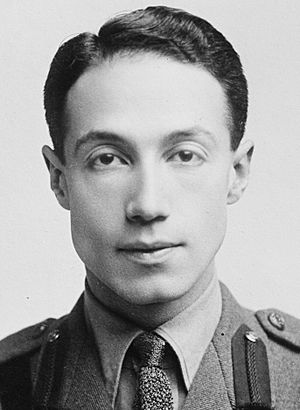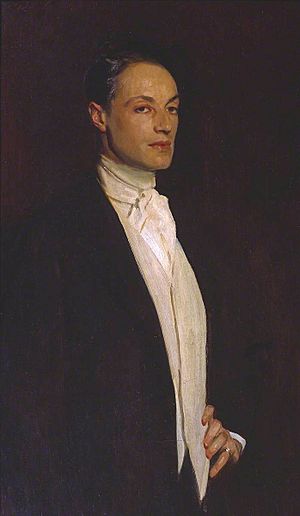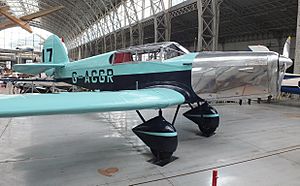Philip Sassoon facts for kids
Quick facts for kids
Sir Philip Sassoon
|
|
|---|---|

Sir Philip Sassoon as a staff officer during the First World War
|
|
| First Commissioner of Works | |
| In office 27 May 1937 – 3 June 1939 |
|
| Preceded by | The Earl Stanhope |
| Succeeded by | Herwald Ramsbotham |
| Personal details | |
| Born |
Philip Albert Gustave David Sassoon
4 December 1888 Paris, France |
| Died | 3 June 1939 (aged 50) London, England |
| Parents | Edward Sassoon Aline Caroline de Rothschild |
| Alma mater | Christ Church, Oxford |
| Civilian awards | Knight Grand Cross of the Order of the British Empire |
| Military service | |
| Allegiance | United Kingdom |
| Branch/service | British Army Auxiliary Air Force |
| Rank | Squadron Leader |
| Commands | No. 601 (County of London) Squadron (1929–31) |
| Battles/wars | First World War |
| Military awards | Companion of the Order of St Michael and St George Knight of the Legion of Honour (France) Officer of the Order of the Black Star (France) Croix de Guerre (France) Officer of the Order of the Crown (Belgium) Croix de Guerre (Belgium) |
Sir Philip Albert Gustave David Sassoon (1888–1939) was a British politician, art collector, and a famous host. He was known for entertaining many important guests at his homes, Port Lympne Mansion in Kent and Trent Park in North London. During the First World War, he served as a staff officer, helping military leaders.
Contents
Family Background
Philip Sassoon came from two very important families: the Sassoon family and the Rothschild family. Both families were well-known for their business success and wealth. He was born in Paris, France. His father was Sir Edward Albert Sassoon, a Member of Parliament. His mother was Aline Caroline de Rothschild.
Philip was also a cousin of the famous war poet, Siegfried Sassoon. His great-grandfather, David Sassoon, started a successful business in Bombay (now Mumbai), India. The family later moved their main office to London. The Sassoons became known for their business skills and for fitting into British society.
Philip went to school at Eton and then studied at Christ Church, Oxford University. While at Oxford, he joined the Royal East Kent Yeomanry, a military group, as a second lieutenant.
In 1912, Philip Sassoon became a Member of Parliament (MP). He also became the chairman of his family's company, David Sassoon & Co., though he didn't manage it day-to-day.
First World War Service
During the First World War, Philip Sassoon worked as a private secretary for Field Marshal Sir Douglas Haig. This was from 1915 to 1918. He was present at an important meeting in France in December 1914. At this meeting, King George V and Edward Prince of Wales met with the French President and top generals. They showed their strong decision to fight against Germany. Because of his many social and political connections, Sassoon was there, even though he was a young officer.
Political Career

Philip Sassoon was a Unionist MP for Hythe starting in 1912. He took over the seat from his father. He was the youngest MP at the time. He was very interested in aviation (flying planes) and even bought his own airplane in 1919. He worked to promote civilian air travel.
He served as a special assistant to Prime Minister David Lloyd George in 1920. From 1924 to 1929, and again from 1931 to 1937, he was the Under-Secretary of State for Air. This role made him very important in political circles. In 1937, he became the First Commissioner of Works. This job meant he was in charge of government buildings and parks. He held this position until he passed away two years later.
His Famous Homes
Philip Sassoon was known for being one of the best hosts in Britain. He owned a house in London, but he also had two other amazing homes.
Trent Park
One of his homes was Trent Park, located in Cockfosters, North London. He hired an architect named Philip Tilden to rebuild the mansion between 1926 and 1931. The house became a beautiful, large mansion in an early Georgian style.
Trent Park was famous for its amazing parties and guests. Important people like King George VI, Winston Churchill, and George Bernard Shaw visited. The house had a luxurious but relaxed atmosphere. It was known for its delicious food and famous visitors.
Philip Sassoon also led excavations at Camlet Moat at Trent Park in the 1920s. He reportedly found old oak beams, Roman shoes, daggers, and mosaic tiles.
Port Lympne Mansion
His other grand home was Port Lympne Mansion in Kent. He had this house designed in 1912. It was a unique building with Italian and Moorish influences. The rooms were filled with bright, exotic colors and the smell of flowers. The gardens at Port Lympne were also very grand and beautiful.
Decades later, Port Lympne became the Port Lympne Wild Animal Park. One frequent guest at Port Lympne was Lawrence of Arabia.
Love for Flying
As the Under-Secretary of State for Air, Sassoon was a leader for No. 601 (County of London) Squadron. This squadron was nicknamed "The Millionaires’ Squadron" because many wealthy people were members.
In 1932, he bought his own Percival Gull monoplane, a type of airplane. It had a special red leather interior. He used this plane to compete in races like the King's Cup Race. This plane is now on display at the Brussels Military Museum. He later owned the first Percival Petrel, another type of two-engine plane.
Sassoon also carried out the first inspection of British air stations overseas. He flew the Blackburn Iris plane for this trip. After his journey, he wrote a book called The Third Route in 1929. The book told the story of how the air route from England to India was developed.
Awards and Honors
Philip Sassoon received several important awards for his service. In 1917, he was made a Companion of the Order of St Michael and St George (CMG). In 1919, he was given the French Croix de Guerre for his excellent service during the war. In 1923, he became a Knight Grand Cross of the Order of the British Empire (GBE).
His collection of awards was sold at an auction in 2012. These included medals from the First World War and special medals from France and Belgium.
Supporting the Arts
Philip Sassoon was also very involved in the arts. He was the Chairman of the Trustees of the National Gallery from 1933 to 1935. As the Minister for Works in the 1930s, he helped make many of London's famous monuments and parks even more beautiful.
He collected art, especially pieces from the English and French 18th century. He also collected works by modern artists like John Singer Sargent. A special glass mosque lamp that once belonged to Sassoon can now be seen in a museum in Lisbon, Portugal.
Death
Philip Sassoon passed away on June 3, 1939, at the age of 50. He died from problems related to the flu. He left behind a large estate. His cousin, Hannah Gubbay, inherited his homes, Port Lympne and Trent Park.
His friend, Noël Coward, described him as "a phenomenon that would never recur." Because he died just before the Second World War began, he became a symbol of a "lost golden era."
Images for kids
-
Sir Philip Sassoon, painted by John Singer Sargent in 1923




